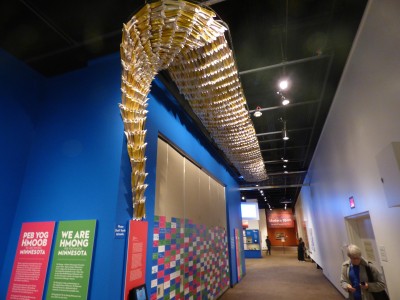
Hmong art is compelling part of new history exhibit
By Levi Weinhagen, St. Paul arts blogger
“We Are Hmong Minnesota,” the new exhibit at the Minnesota History Center developed in partnership with many individuals and organizations active in the local Hmong community, does an amazing job of letting visitors stand in the past and look through the present into the future.
The diaspora of Hmong people out of Laos and the resulting waves of immigration into the United States, echoes 20th century Jewish experiences with displacement, while also drawing clear lines to the ongoing Somali diaspora. As a result of the exhibit’s layout and the ways the histories are shared, this exhibit facilitates an understanding of the journey of the Hmong people, from their lives in Laos to becoming actively engaged Minnesota citizens. It is also an incredibly insightful representation of virtually every displaced immigrant community that has ultimately made the United States its home.
There are a great many elements to recommend a visit to “We Are Hmong Minnesota.” There are at least three places where you can stand in the exhibit and find yourself looking at a traditional Hmong story cloth or a handmade ceremonial dress. But also directly in your eye line is a yard sign from Mee Moua’s re-election campaign in 2006, after having been the first Hmong-American woman elected to a state legislature, or a U.S. Army uniform. The exhibit visually demonstrates how very American Hmong people have become, while keeping their past and traditions alive. Arguably, though, the most interesting and exciting part of the exhibit is just how much art is represented.
The Hmong story cloth may be one of the most compact versions of storytelling in the world of art. “We Are Hmong Minnesota” features three different story cloths, including the largest in their collection, and together they represent all the ways a Hmong story cloth can work. The largest cloth tells a relatively linear tale of war, refugees and traveling to America. The smaller cloths more abstractly represent the 18 Hmong clans and the Hmong people’s relationships with animals and nature.
Sieng Lee, artist and 2014 Jerome Foundation Fellowship winner, created an installation piece for the entrance of the exhibit called “Let Our Spirit Fly.” In a nod to the use of folded paper boats in funeral ceremonies, “Let Our Spirit Fly” creates an expanding wave of shimmering gold that draws the visitor into the exhibit with an energy and vibrancy not often seen upon entering a history museum exhibit. The exhibit explains that “the offering of spirit money to the ancestors will bring about protection, abundance, health and healing.” “Let Our Spirit Fly” serves as a pronouncement that this exhibit is a celebration of Hmong culture, but also an act of healing.
“Let Our Spirit Fly” by Sieng Lee.
There’s a wall in the back of “We Are Hmong Minnesota,” which all by itself is worth the price of admission. It’s an attempt, and a seemingly successful one, to collect modern day art from Hmong artists that speaks to all elements of the experiences of being Hmong in America and being American in the Hmong community. From painter Seexeng Lee, who first drew pictures with a stick in the soil while in a refugee camp in Thailand, to Kao Lee Thao, who was born in Wisconsin and has academic arts training, the work on displays covers everything from the Hmong refugee experience to work that isn’t about being Hmong but is informed by Hmong culture and history.
The back wall also features a series of video screens that show a wide variety of clips from things like Hmong news programs presented in Hmong-Mein languages, Hmong fashion shows, a performance by National Poetry Slam finalist Bao Phi, and Richard Louprasong’s “Draw My Hmong Life.” Most of the artwork presented on this back wall has been displayed in other places, and some of it can be watched online, but seeing it all together – especially after being exposed to the compelling history and the present of the Hmong experience – changes the power of the work.
“We Are Hmong Minnesota” is on view until Nov. 29 at the Minnesota History Center, 345 W. Kellogg Blvd., St. Paul; 651-259-3000; minnesotahistorycenter.org.
Recent Content
-
Artsarticle ·
-
Artsarticle ·
-
Artsarticle ·


